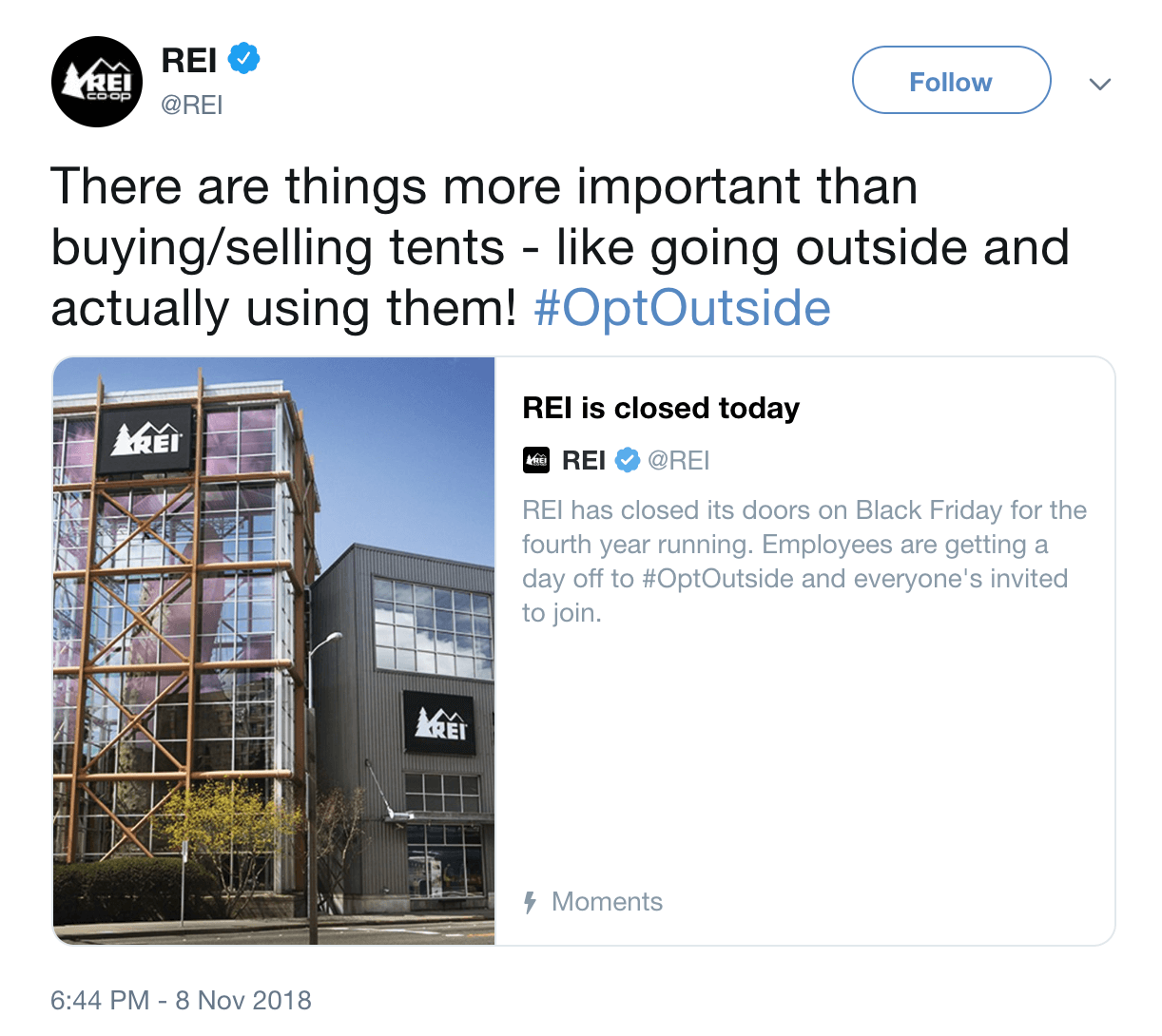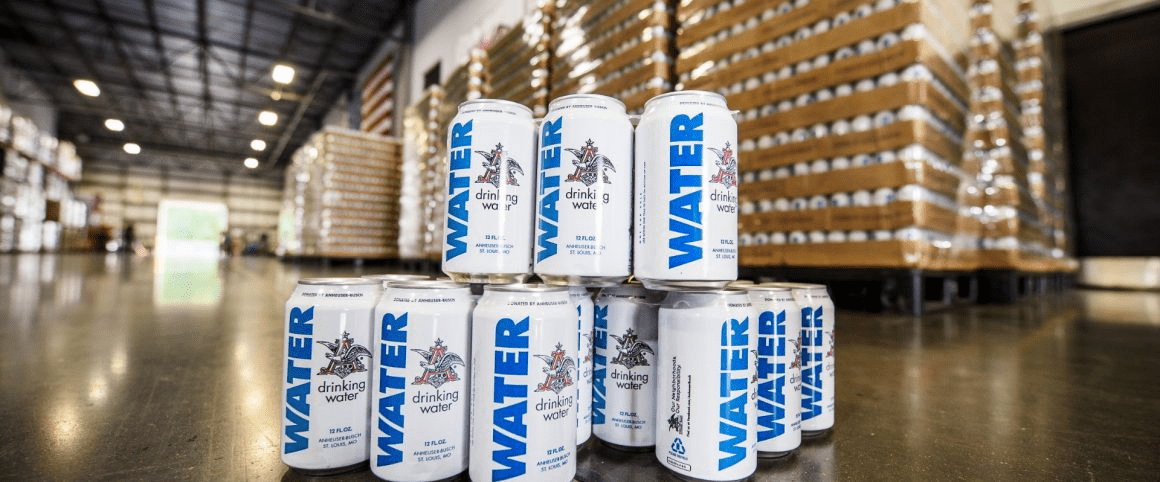Black Friday is the busiest shopping day of the year in the U.S., with more than 116 million people hitting the shops in search of a great deal.
But REI, an outdoor clothing and equipment brand, does Black Friday differently to other retailers. For the fourth year in a row, REI closed its doors on Black Friday 2018, giving every one of its 12,000 employees the day off to enjoy the outdoors.
“There are things more important than buying/selling tents – like going outside and actually using them,” it explained on Twitter.

It might seem counter-intuitive to think that closing all your retail stores on the busiest shopping day of the year will be good for business. But that’s exactly what REI has found.
REI’s CEO, Jerry Stritzke believes that the relationships between consumers and brands are changing — whilst you used to be able to win people over with deals, you now need “something more”, he told Business Insider.
And it seems that Stritzke’s intuition has led REI down the right path.
“Since launching #OptOutside, we’ve watched more than 200 retailers go out of business,” Stritzke told BestBlackFriday.com. “We’ve stayed healthy partly because we’ve stuck with our core values — like giving our employees time to do what they love with the people they love during the holidays. It’s enabled us to add millions of new members and, most importantly, connect millions of people with the outdoors.”
According to data from Edelman, sixty-four percent of consumers around the world will choose, switch, avoid or boycott a business based on its stand on societal and political issues.
But taking a stand isn’t as simple as jumping in on a trending topic on Twitter, or sharing a quick piece of content here and there. It must run much deeper than that.
“You have to be walking the walk before you talk the talk,” Mike Dupree, Senior Manager for Media & Entertainment at Twitter, explained to me.
Mike has been working with brands on their content and marketing efforts on Twitter for over six years, and he recently jumped on a call with me to explain the power of purpose-driven marketing — the topic of his talk at this year’s Social Fresh conference.
Demonstration before communication
REI’s Opt Outside campaign has been incredibly successful since it first launched in 2015 because it’s not just a marketing front — even REI’s CEO, takes Black Friday off to enjoy the outdoors.
And Mike believes that this authenticity is key, not only to REI’s success, but to any purpose-driven campaign: “Being authentic is always critical in marketing, but when it comes to brand purpose it becomes even more important.”
“Any purpose-driven campaign shouldn’t be viewed as a short-term thing,” Mike explained. “The purpose has to be deep rooted in the company across all facets of the organisation — from marketing and customer service to communications and policy, and everywhere in between.”
“In short, it’s about demonstration before communication,” Mike concluded.
This is exactly why Opt Outside has worked for REI. For years before it launched the campaign, and communicated its “Opt Outside” ethos, it had demonstrated it through its actions. Enjoying the outdoors is a part of REI’s brand message, and over the years it has consistently supported nonprofit partners, and encouraged both employees and customers to make the most of the outdoors.
Having a purpose without being divisive, or taking sides
“We know that consumers will buy or boycott brands based on a social or political issue,” Mike explained. “So there’s always a risk when you choose to be bold.”
But to stand for something, and embrace a purpose, brands don’t need to create campaigns that choose sides on political, or social topics.
“We’ve seen numerous examples of brands taking a stand without taking sides,” Mike told me. “The key is to find universal issues that strike a cultural chord with anybody — something that everybody can get behind.”
For example, throughout 2018 brands have consistently helped out with disaster relief efforts after after hurricanes, superstorms, and earthquakes.
Verizon deployed mobile towers and generators to those regions prone to natural disasters so that it could assist with communication during disaster relief. It then communicated this by creating a campaign, #AllOurThanks, that enabled people to share their gratitude to first responders who are always there in times of crisis.
And Anheuser-Busch sent more than 300,000 cans of emergency canned drinking water to local communities in North Carolina, South Carolina, and Virginia as the states prepared for the expected impacts of Hurricane Florence.

This action wasn’t a one-off, though. Water is incredibly important to Anheuser-Busch’s brewing process, and it has been committed to conserving water for years as part of its Better World focus. Since 2010, it has partnered with the River Network to host a series of local river and watershed restoration and protection projects.
3 steps to finding a purpose that aligns with your brand
The campaigns we’ve discussed so far (REI, Verizon, Anheuser-Busch) all have something in common:
The purpose they support is fully aligned with their brand — and that’s not an accident. As Mike explained:
“Ideally as a brand you decide to choose an area that aligns with your brand purpose that also connects with your overall brand ethos, and the product/service you offer. If you choose that well, having your brand be a part of the campaign shouldn’t be taken the wrong way.”
Here are three things to consider before aligning your brand with a purpose:
1. Does your brand have a right or role to be here?
You never want to shoehorn your brand into a conversation in which it doesn’t belong. “This can be a PR nightmare,” Mike told me.
The best examples of purpose-driven marketing are when brands connect with issues and purposes that they have long supported or played a part in. Anheuser-Busch’s water campaign worked for its brand because it has been supporting clean water-related causes since 2010 — it wasn’t just jumping in during a moment of crisis to try and grab some attention.
“If you’re already walking the walk as a brand, you’ll know what discussions to be a part of and where to stay away,” Mike explained.
2. Are you doing or just saying?
It’s not enough to simply jump into a conversation during a fleeting moment, you have to have actions that back up your communications.
“Consistency over time is important,” Mike told me. “If you want to build an enduring connection with your customers you have to have consistency over time. Both in what you’re doing and what you’re saying.”
Mike continued: “If it’s just a trending hashtag or we’re in the middle of a crisis and you want to jump in quickly to get some social media micro-wins, that’s not going to help your brand and it’ll probably hurt your brand in the long run.”
3. Will this stand up in five years from now?
This is a great question to ask yourself. When it comes to purpose-driven marketing, you need to think about how this campaign will be looked back on and how it might shape your business moving forward.
If it’s fully aligned with your business ethos and historic actions, you’ll more than likely look back on it as a positive. But if you’re just jumping into a trending topic, or something your brand isn’t fully aligned with it probably won’t stand the test of time.
Take the REI “Opt Outside” campaign. The team at REI knew that it was completely in-line with its business ethos, and the impact would be seen as positive — even if it did lose out on sales on the biggest shopping day of the year.
“REI is a retail brand that has a business interest in Black Friday. But it has more of an interest in embracing the outdoors lifestyle and culture than it does in one big shopping day each year,” Mike explained. “It believes that this approach will keep customers coming back, and build loyalty that lasts years, and years.”
You’re never too small to have a purpose
Verizon, REI, and Anheuser-Busch are huge brands. But that doesn’t mean a smaller business can’t make an impact with purpose-driven marketing.
Just look at businesses like TOMS. When TOMS first launched its shoes, its purpose was front and center: for every pair of shoes you buy, another pair will be donated to people in need in countries around the world.
And no matter your size, embracing purpose-driven marketing is a great way to stand out and build strong, lasting relationships with consumers.
“It’s never been harder for brands to stand out and make connections that are enduring if you can do that it’ll help your business [in the long-term],” Mike concluded.
“We see that 75 percent of consumers expect brands to make a contribution to their well-being, and quality of life — if you aren’t doing that you’ll be left behind. And that’s applicable to businesses of any size.”
Try Buffer for free
190,000+ creators, small businesses, and marketers use Buffer to grow their audiences every month.



